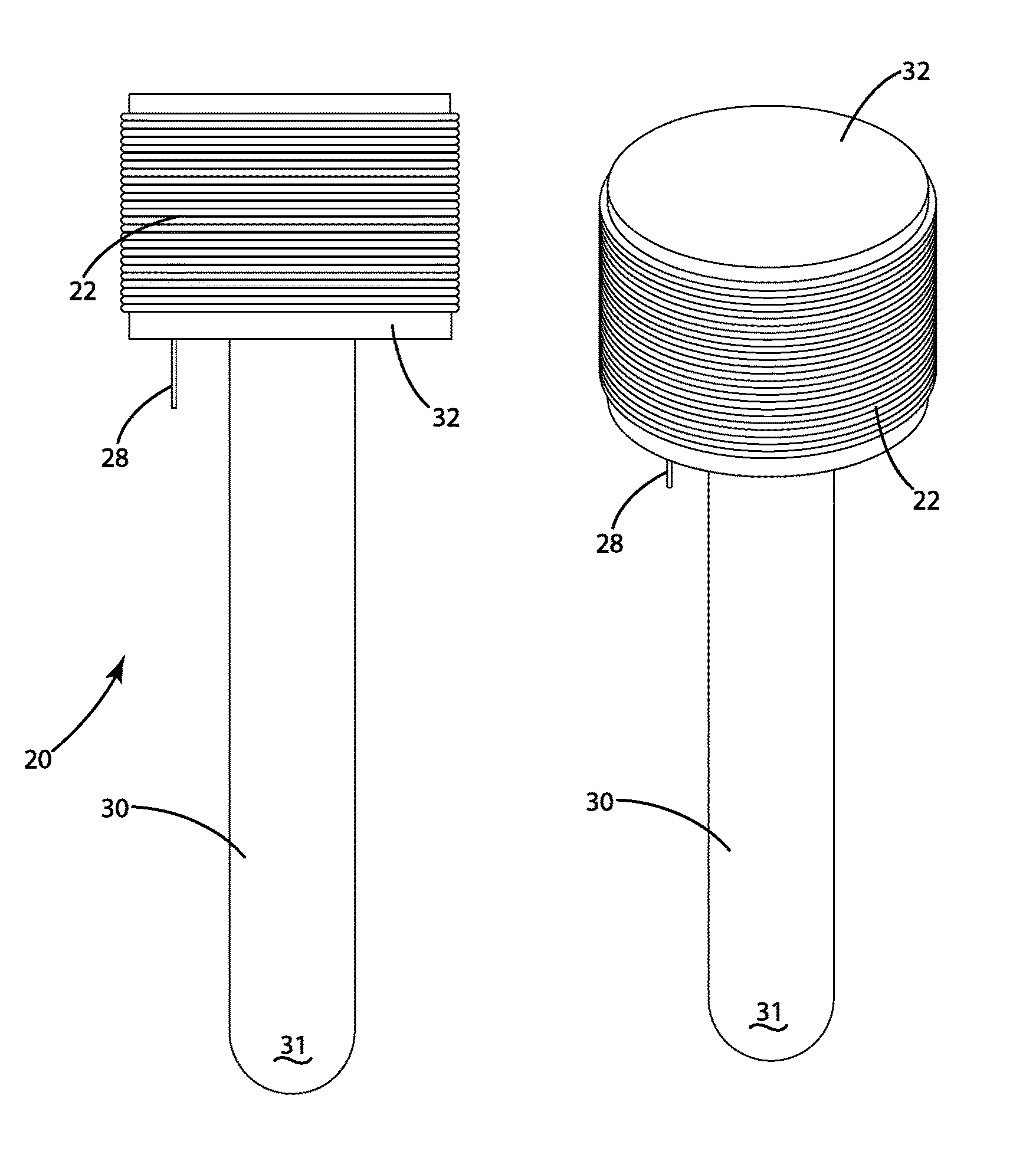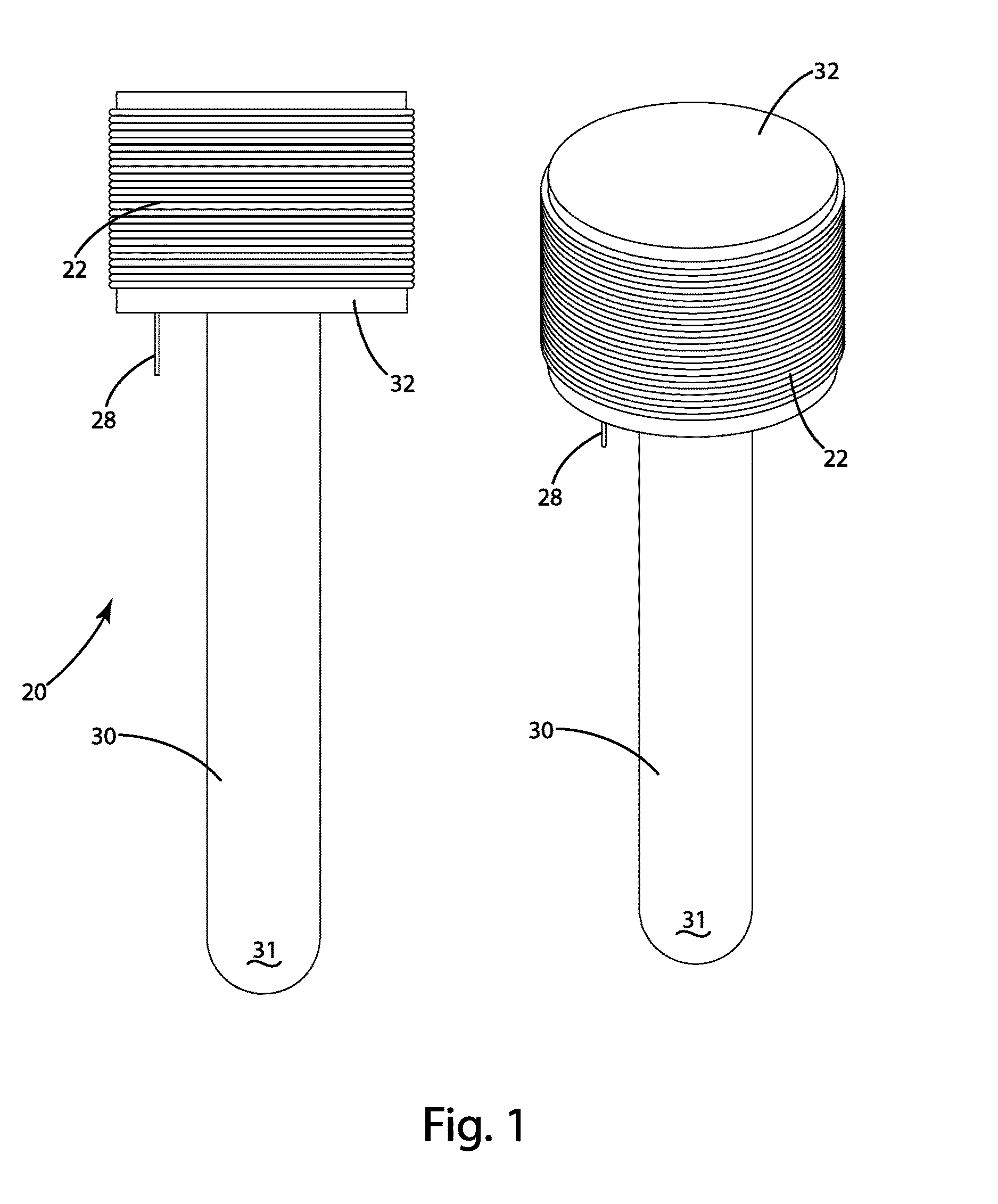Inductively coupled dieletric barrier discharge lamp
a technology of dielectric barrier and discharge lamp, which is applied in the direction of water treatment parameter control, specific water treatment objectives, and separation processes, etc., can solve the problems of fluid irradiation at levels above or below the level needed for adequate treatment, and the connection between the transformer and the lamp body can be susceptible to fluid and corrosion, and achieve the effect of preventing ionization
- Summary
- Abstract
- Description
- Claims
- Application Information
AI Technical Summary
Benefits of technology
Problems solved by technology
Method used
Image
Examples
first embodiment
[0036]Referring now to FIGS. 1-3, a lamp assembly is illustrated and generally designated 20. The lamp assembly 20 includes an inductive secondary or secondary coil 24 adapted to receive wireless power from a nearby inductive primary or primary coil 22, a first electrode 26 electrically coupled to the secondary coil 24, a second electrode 28 electrically coupled to the secondary coil 24, and a dielectric barrier discharge lamp body 30. The secondary coil 24 can include any element adapted to generate an internal electrical current in response to an external time-varying electromagnetic field. For example, the secondary coil 24 can be formed of a conducting element wound one or more times around an axis, while in other embodiments the secondary coil 24 can include a stamped or printed conductive winding in a non-conductive substrate. The first and second electrodes 26, 28 can be an extension of the secondary coil 24, or can be separately formed and electrically coupled to respective...
third embodiment
[0048]Operation of the third embodiment can be described in conjunction with the flowchart of FIG. 13. When water flow is detected by the water flow rate sensor 50 in step 102, the microcontroller 44 causes power to be delivered to the primary coil 22 at step 104. The level of power to be delivered at step 102 is determined by the microcontroller 44 by formula or through the use of a look-up table substantially as set forth above. At step 106, the microcontroller 44 verifies operation of the lamp through the lamp sensor 108. If the lamp is verified to be on and at the correct intensity, the lamp pulse driver 46 will continue to deliver the same power to the primary coil 22. If an adjustment is needed at step 108 based on the output of the lamp sensor 48, the water flow rate sensor 50 and / or the water quality sensor 92, the system may also adjust the power delivery to the primary coil 22. For example, a lower turbidity can require lower ultraviolet lamp intensities, while a higher tu...
fourth embodiment
[0051]Operation of the fourth embodiment can be further described in conjunction with the flowchart of FIG. 15. When water flow is detected in step 130, optionally via a water flow rate sensor 50, the primary coil 22 operates in a communications mode to read wireless data from the memory tag 120 associated with (or contained within) the secondary lamp assembly 20 at step 132. As noted above, the wireless data can include the cumulative prior operational use data and a unique lamp serial number. At step 134, the primary coil 22 can operate in a power supply mode under control of the microcontroller 44 and lamp driver 46 to provide power to the secondary coil 24. The amount of power applied at step 134 can vary from application to application, and can be based at least in part on the fluid flow rate and the cumulative prior operational data to achieve a desired lamp intensity. At step 136, the microcontroller 44 can evaluate or read the output of the lamp sensor 48, the water flow rat...
PUM
| Property | Measurement | Unit |
|---|---|---|
| wavelengths | aaaaa | aaaaa |
| wavelengths | aaaaa | aaaaa |
| wavelengths | aaaaa | aaaaa |
Abstract
Description
Claims
Application Information
 Login to View More
Login to View More - R&D
- Intellectual Property
- Life Sciences
- Materials
- Tech Scout
- Unparalleled Data Quality
- Higher Quality Content
- 60% Fewer Hallucinations
Browse by: Latest US Patents, China's latest patents, Technical Efficacy Thesaurus, Application Domain, Technology Topic, Popular Technical Reports.
© 2025 PatSnap. All rights reserved.Legal|Privacy policy|Modern Slavery Act Transparency Statement|Sitemap|About US| Contact US: help@patsnap.com



